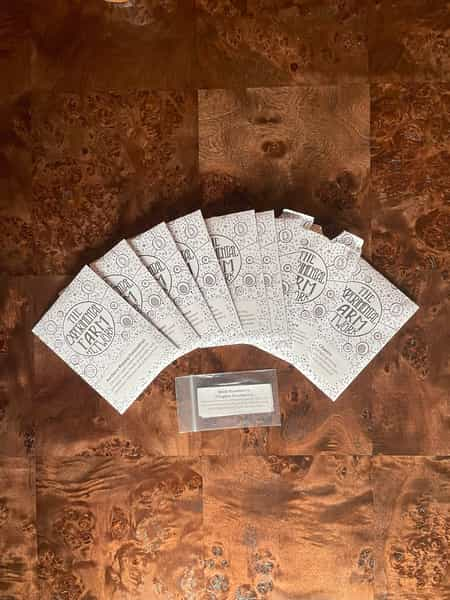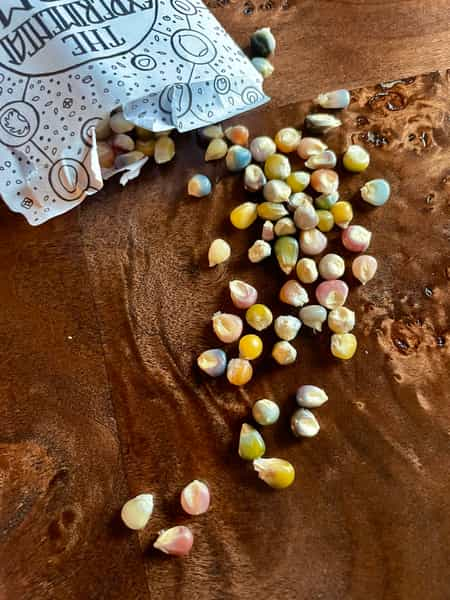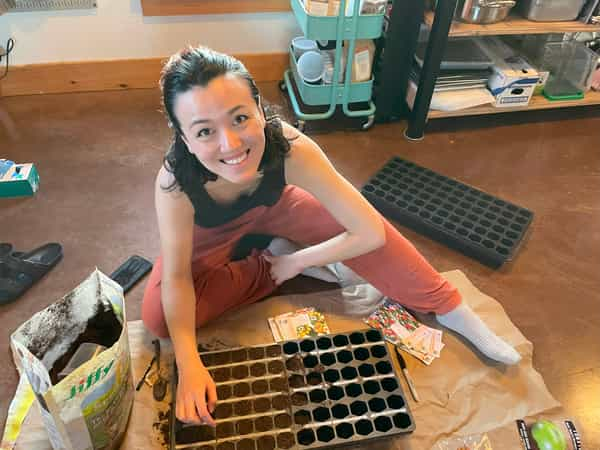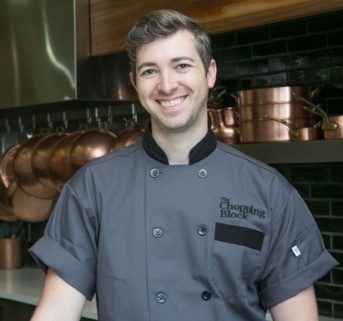I’m sorry to have kept you waiting so long for the follow up to my previous post regarding planting a delightful little garden as I know many of you were clamoring to know what seeds I had ordered for this year's garden. Well un-bate your breath friends, because your wait has finally come to an end. This year I ordered all my seeds from the amazing Experimental Farm Network. You can learn about them on their webpage or you can listen to the equally amazing podcast Poor Prole’s Almanac (really can’t recommend it highly enough) which has an interview with Nate Klein who runs the EFN operation (the episode is called ‘Breeding Future Foods’ and came out 6/23/23).
 Because we already had a good number of seeds leftover from last year, I was faced with the exciting prospect of being able to just browse for anything interesting that we could conceivably grow with our limited space. I spent a while just browsing what was on offer, and found myself wishing I had about ten times as much garden space with which to experiment.
Because we already had a good number of seeds leftover from last year, I was faced with the exciting prospect of being able to just browse for anything interesting that we could conceivably grow with our limited space. I spent a while just browsing what was on offer, and found myself wishing I had about ten times as much garden space with which to experiment.
One of the cool things about the Experimental Farm Network is that a lot of space is taken up by breeding new heartier varieties of many different crops, and anyone who’s interested can join projects as a volunteer. That means you–yes, you–could be responsible for the introduction of a new variety of corn that fixes nitrogen from the air, and sequesters as much carbon as 10 acres of forest, and tastes like roast beef, and has rudimentary sentience. Right now they are recruiting volunteers to help with a cold hardy avocado variety. Imagine living in Illinois and being able to go pick an avocado off the tree in your backyard. Incredible.
But enough chit chat about the future of our regional foodways and the important work being done to help avoid widespread famine during the coming climate apocalypse (I’m not actually a climate change doomsayer, by the way. I think there is still a lot we can and should do, to curb the worst of what’s coming. However, given the current trends I think it also makes a lot of sense to prepare as best we can for the “what if we just did nothing” scenario we seem determined to pursue). Let's get to the good stuff. What you’ve all been so eagerly awaiting. The most exciting and not at all boring part that everyone’s been clamoring to hear: what new plants am I personally planning to grow this year.

Glass Gem Popcorn
This is a variety you have maybe heard of. It has gone viral a few times in the last couple years for its multi-hued kaleidoscope of glossy popcorn kernels. It really is probably the most flamboyant and ostentatious corn on earth. Though many websites will refer to it as an ‘heirloom’ variety of flint corn, this use of the term heirloom is – either intentionally or not – a bit misleading. It is a modern variety bred by an indigenous man named Carl “White Eagle” Barnes in the 1980’s. I'm really looking forward to seeing these beautiful cobs towards the end of the summer.
Lava Lamp Romaine Lettuce
A beautiful red speckled romaine developed by breeder Frank Morton. It has the look of a fancy italian chicory, but isn’t bitter even after bolting, and has a satisfying juicy crunch.
Wild Virginia Strawberry
This is a wild strawberry native to the eastern U.S. I am a bit of a sucker for strawberries, especially ones that are closely related to their wild counterparts, so when I learned about this one that's actually native to (roughly) where I live I couldn't resist. Not only is it cute, and packed with flavor (if you’ve never had a wild or wild-like strawberry they are on a whole different level when it comes to flavor), but this is one of the parent varieties of domesticated garden strawberries. How cool is that?
Wild Garden Lettuce Mix
The name here is pretty self explanatory. An incredibly diverse array of different garden lettuces. Perfect for harvesting salad mix, or for developing new varieties if that's what you’re into. This mix was also developed by Frank Morton of Lava Lamp Romaine fame.
‘Delft’ Leek
An almost comically perfect looking large leek. But its size doesn't mean it’s tough like it can with some crops. These leeks still melt into tender ribbons with a brief sauté. We didn’t grow that many vegetables in our garden last year, and little leeks are so cute coming up from the ground it seemed like a good option to try out this year.
Bok Choi Grex
A freely interbreeding mix of different bok chois and their closely related chinese cabbage type vegetables. We love bok choi, but always find that the 2 lb bag we have to buy from the local Asian grocer is too much for us to finish before it goes bad. Growing our own seemed like the perfect solution, and made all the more exciting by the prospect of being surprised by novel varieties.
Wild Garden II Chicory mix
Another leafy green mix by – you guessed it – Frank Morton. This time, it's a mix of beautiful chicories. This mix is incredibly diverse. Frank took a mix of 11 Italian chicory varieties and grew them together, letting them seed together to create new varieties. He then combined the new hybrid seeds with the original Italian stock to create this mix. I love chicories and radicchios of all types, so I’m super excited to see what this mix turns out.
‘Santo’ Cilantro
This is a great garden cilantro because it is bolt resistant, so it will produce leaves for a longer time before going to seed. This makes it a great cut-and-come-again variety. It is also fast maturing with a pronounced cilantro flavor. Last year I could barely get one use out of my cilantro before it bolted, so I’m looking forward to this variety.
‘Resilient Shishito’ Pepper
We love shishito peppers. We grow them every year and always wish we had more. This variety is a bit hardier and produces a crop earlier in the season, but also the fruit is humungous compared to most other shishitos I’ve seen. These peppers can get to be four or five times the size of a typical shishito. All the better for us!
Northern Maypop Passionfruit
This is probably the one I’m most excited for. Some people grow passionfruit in the northeast for the beautiful flowers it produces, but these are usually ornamental varieties that can’t produce fruit in our climate. Imagine my delight when I discovered not only is there a passionfruit that is actually native to the Northeast (this is still blowing my mind actually), but it produces fruit, and if given the right conditions, can even fruit in its first year! Local passionfruit! No more scouring the lands in search of rare and highly toxic (if under ripe) mayapples in search of tropical flavor!
 Getting starting started
Getting starting started
I hope this post inspires you to peruse the selection of seeds available to you in your area in hopes of finding something exciting. And if you feel like your skills in the kitchen don't quite equal the ambitious garden you have planned, I recommend checking out our upcoming Culinary Boot Camp which will give you all the skills to deftly prepare even the strangest of produce that might come out of your garden.











